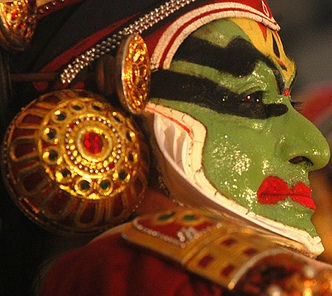KATHAKALI
Kathakali is one of the oldest theatre forms in the world. It originated in the area of southwestern India now known as the state of Kerala. Kathakali is a group presentation, in which dancers take various roles in performances traditionally based on themes from Hindu mythology, especially the two epics, the Ramayana and the Mahabharata.
One of the most interesting aspects of Kathakali is its elaborate make-up code. Characters are categorized according to their nature. This determines the colours used in the make-up. The faces of noble male characters, such as virtuous kings, the divine hero Rama, etc., are predominantly green. Characters of high birth who have an evil streak, such as the demon king Ravana, are allotted a similar green make-up, slashed with red marks on the cheeks. Extremely angry or excessively evil characters wear predominantly red make-up and a flowing red beard. Forest dwellers such as hunters are represented with a predominantly black make-up base. Women and ascetics have lustrous, yellowish faces.
The technique of Kathakali includes a highly developed language of gesture, through which the artist can convey whole sentences and stories. The body movements and footwork are very rigourous. To attain the high degree of flexibility and muscle control required for this art, a Kathakali dancer undergoes a strenuous course of training, and special periods of body massage.
The dancers wear large head dresses, and the contours of the face are extended with moulded lime. The extraordinary costumes and make-up serve to raise the participants above the level of mere mortals, so that they may transport the audience to a world of wonders.
The orchestra of a Kathakali performance includes two drums known as the chenda and the maddalam, along with cymbals and another percussion instrument, the ela taalam. Normally, two singers provide the vocal accompaniment. The style of singing particular to Kathakali is called Sopaanam. The orchestra of a Kathakali troupe is unique and provides not only the background to the dancing, but also serves as a highly expressive special effects team. In the traditional village ambiance, the percussionists also provide publicity for the event by playing outside the venue for some hours before the start of the show.
A traditional Kathakali performance begins in the evening and continues throughout the night, culminating at the auspicious hour of dawn, when Good finally conquers Evil. Today, however, it has been modified for the proscenium stage, and urban audiences can participate in this ritualistic theatre experience in the comfort of a plush auditorium, within the span of a couple of hours.
Kathakali literally meaning “story dance” is the pantomimic dance drama,the dancing and the acting being blended together into an inseparable form.It is a combination of facial expressions and body movements which brings out the thought and emotion of the character.
Kathakali is predominantly a male art and the dancing is mostly of the masculine type.The position taken by the actor is angular.He never stands erect while acting,his knees being spread out and his legs forming a rhombus,his hands bent at the elbow and his palms on his hips.The outer feet are never flat on the ground and still the actor maintains a perfect balance.The female character is lasya which is gentle and grateful.This is particularly evident in love scenes
The traditional performance begin at 8 pm and goes until dawn the following morning.It is preceded at sunset by the Kelikottu which is the playing of drums,Gong and cymbals to inform the local people about the performance.Now a days performances are given in halls with footlight and microphones etc. which will not last more than 3 to 4 Hrs. Kathakali plays are mainly based on the stories from the hindu epic Mahabharata,Ramayana and Bhagavata purana and characters represent the mythological being of the 3 world.The upper(devas or gods),the middle world of humans and the nether world(asuras or demons).The costume and make-up transform the actor mentally and physically to portray the character Kathakali’s origin and development owe gratitude to the Royal family of Travancore.The Raja of Kottarakara(17 century) is the earliest exponent of this art.During his time Kathakali plays were staged continuously for 24 hours without any break.
A person to enjoy the Kathakali performance he should be aware about Hindu mythology,the character,The make up,the costume,the mudras and finally the slokas or verses sung by the singers.
Source : artindia.net


